By Rob and Brenda Miller
November 6, 2014
How my trip to China got started
Early in 2014 I was contacted by a company interested in representing my patterns in China. The proposal came first via email, and it seemed like one of those emails you get from time to time that might be somewhat questionable. I read it over a couple of times and then decided to do a little fishing myself and asked some questions. As soon as I replied there began an email conversation with the group that went on for a couple of months.
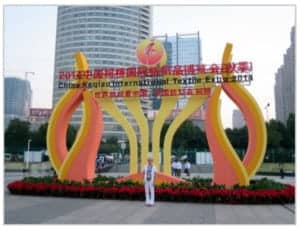
Then I received an invitation to attend a Textile Expo in China as a representative of Canada’s quilting community, to promote quilting in China. I replied that although going to China would be wonderful, I couldn’t come. A reply quickly came back that said they were so happy I could come. After considerable negotiation and back and forth emails we came to an agreement.
My husband and I would be going to show samples of my patterns in a 10 x 10 foot booth, teach a class, speak and be part of a question and answer forum. It was going to be a great adventure! We were going to Shaoxing, China in October of 2014.
The China Textile City Textile Expo
Upon arrival, I discovered that I was the only quilter from North America represented at the Expo in their speaking forums. Two people from the United States, representing American Quilting Association Bonnie Browning and Ann Hammel had been invited and were there to check it out and offer advice on having shows, but they did not have a booth and they were not directly involved in the forums or teaching sessions. Marin F Hanson from the University of Nebraska was there, but she was involved more in presenting historical quilts, and building a relationship with the University there regarding the study and preservation of quilts.
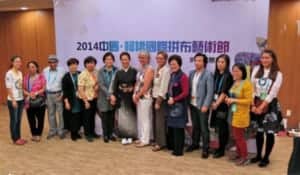
But in addition to me, there was also a single representative from Mainland China, Jin Yuanshan, one from Korea, Kim Misik, one from Japan, Qi Teng, one from Taiwan Lin Xingzhen, and there was a fabric manufacturer from Australia from M & S Fabrics Sham Lohani who came with his wife Momo, and his wife was a quilter. So I was presented and honored as an internationally respected expert quilter and teacher from Canada.
We brought along 2 suitcases of my quilts and bags, and set up our booth, just as I would have if I had gone to Houston or Minneapolis, or Pittsburgh to the wholesale show called Quilt Market.

Arrival in Shaoxing
You must understand a little bit about where we were, and how we felt as we arrived. We come from a small town in rural south-western Ontario, with maybe 13,000 people. To us, Toronto is a big city, with its 2.6 million people. We flew to Shanghai, which dwarfs Toronto, with almost ten times the population, over 24 million.
We were met by a driver who spoke no English, and he drove us three hours to Shaoxing, which is somewhat smaller than Shanghai, but still about 4 times the size of Toronto, over 8 million people.
Shaoxing is the hub of textile manufacture and distribution for China and it serves all of Asia. There is one other megacity that has a similar, perhaps even bigger textile show twice a year, associated with Canton, in Guangzhou of Guangdong Province. But Shaoxing is the birthplace of the silk industry so it has a long tradition of textile production and quality. It is a prefecture city, sort of sprawling county-sized city that contains many cities within it. We were in Keqiao, literally known as textile city.

History of the China Textile City Textile Expo
The China Textile City Textile Expo started in 1999, and by 2006 it was considered a key exhibition in Chinese domestic trade by their Ministry of Commerce; the state gave it full backing, and the next year it was international in scope. It is now held twice a year.
By 2009, the fashion industry and printing industry in China joined the show.
By 2013, the expo had 1423 booths, about 30,929 professional purchasers, 6906 from overseas, and the trade volume was RMB 338 billion (Yuen).

Where was the cotton?
But the first day of the show, the two representatives for AQS walked around and came back to report that there were almost no cotton fabrics to be seen in the show. The number of polyester, rayon, knit, silk, etc. were staggering. 83% of the world’s man-made textiles come from Shaoxing or pass through its trading infrastructure. What is more, most of the world’s cotton is grown in China and India, yet cotton fabric is conspicuously missing at this show.
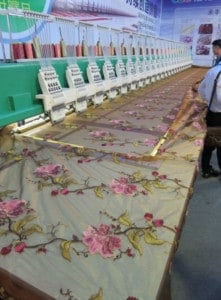
There were a couple of booths near us: M&S Textile from Australia was there, with its aboriginal prints.

And Baofang had a huge booth beside us, and they manufacture wax prints with African designs.

And we noticed right away that my booth was very popular, almost unnervingly so. This show was open to the public, and to industry, and to education facilities, and it was almost impossible to tell precisely who you were talking with at any given time. There were vendors and buyers and gawkers from everywhere in China, and many from the Middle East, from Indonesia, from Pakistan… some spoke English, but most did not.
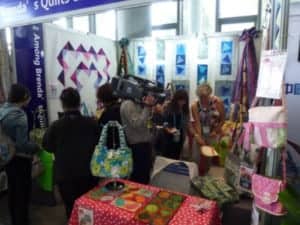
My translator was a huge help
I was provided with a student translator from the university who we called Yuki. She was in her second year in training, learning English translation and she had two years to go before graduating. She was not being paid for her time with me, but she was simply told by her teacher that it would be good experience. She did not know how to sew. Despite that, we had fun, and we worked together well, and she had excellent skills and did a great job.
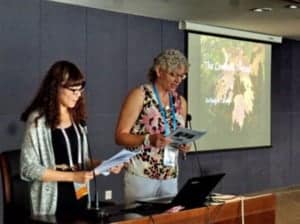
I was promoting quilting, not trying to sell my goods
At least two different manufacturers approached me and said they would like to make and distribute my bags, they would like to mass produce them. But I hadn’t come here for that. And there were people there who pointed to my quilt and pillow set and without asking the price, they said, “I’ll take 100 of those quilts with pillows to match and 20 of these…” And you just had to say, “no, these are not for sale.” This is a sort of typical conversation:
(He grabs the bag)
How much?
You cannot buy these bags.
But what is their price?
They are not for sale.
But if I could buy them, what is the purchase price?
You misunderstand: you cannot purchase them at any price, you must make them. Each is handmade, unique.
How much if you make one?
My wife will not make them for you. But she designs them, you can purchase a pattern (although not here at the show, there are no translations!), and from the pattern, you can make one or two for yourself by hand.
What will the cost for that be?
It depends. Do you already have the fabric? Do you charge yourself for your own time? This is a craft. In some cases, it can cost nothing to make. You can, in fact, make it or something similarly lovely with nothing but scraps. But you cannot buy these bags. In some ways they are priceless.
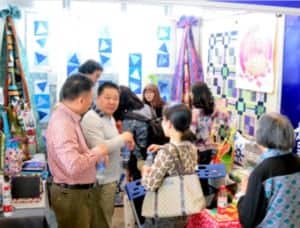
This was a concept that was very difficult for everyone to grasp, and it may be hard for you to understand too. I was invited there not to promote my own bags or pattern designs, but to promote quilting. That was what I was told to do, and I honored my part of the bargain. But, there was a lot of interest generated by my booth. And whether it was my bags, or the fabric, or the exotic nature of it, because we came from Canada, I don’t know – probably all of the above. But in all the show, there was nothing like my humble little booth.
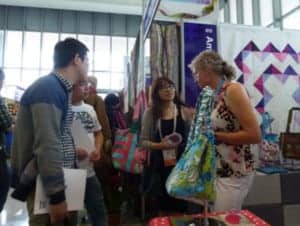
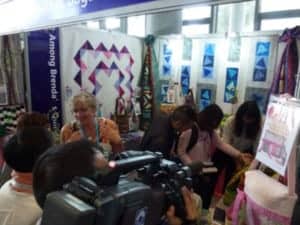
Discussion about selling my designs
We sat down with Mr. Yang and his interpreter Jenny, trying to figure out how to move forward with Mr Yang selling my designs in China. They would have to be translated into Chinese. It was felt that they needed some sort of video training to go along with them. But Mr. Yang wanted all of my samples, and I refused to part with them. He offered to buy them all, but I don’t have time to make all of my samples again, I’m too busy designing new stuff, and besides, I need my samples for my own business. So we reached a sort of stalemate about how to move forward.
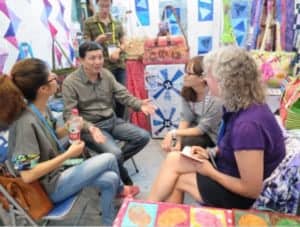
Limitations of quilting in China
One thing that became obvious was, China does not have the infrastructure in place yet to support a quilting industry. I believe they are serious about starting it up, the government wants to get this into the hands of the people. But from what we’ve seen, although their fashion sense is keen, the Chinese do not have the amazing breadth of choice of cotton quilting fabric that we take for granted in the west. They don’t have anything like our fat quarters or bali pops – precuts that are designed to make the quilter’s tasks easier.
Mr. Yang recognized the superiority of the fabric and fashion sense that set my bags apart, and he wanted me to introduce him to Hoffman California Fabrics, one of the fabric manufacturers and distributors with whom I have a business relationship with, and he wanted me to use my influence there to get him the very best price so he could sell it in China. How does he want to sell my patterns and the fabric that everyone would love to use, but can’t get yet? He expects to sell it online.
How do you sell fabric online to people who love to touch?
Now, coming from the west, with our many quilting stores and textile stores, this seems a bit strange. As I pointed out to everyone who came to my talk in China, quilters are tactile people: they love to see beautiful things, but they also love to touch it, to feel it. This is absolutely true of the Chinese consumer too, even more so, no matter what they are buying. Now, walking into a quilt shop in Canada or the U.S. is like poking around in someone’s stash, you just want to touch it and admire it, and become inspired by the patterns and the texture, and take it all home. You also expect a certain amount of expertise from the shop owners who can advise on color and design elements or make suggestions for battings, hardware or new materials. This is a fashion industry that constantly changes, so we think we need a chain of distributors who are passionate about it, so that we can stay current with trends. How can any of that be achieved with mere online distribution?
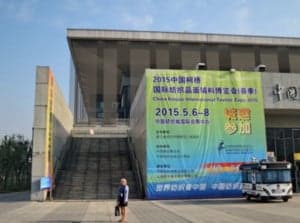
On the other hand, we should not dismiss this idea of selling fabric and notions online out-of-hand. While in China, on our jetlagged nights, we were reading a book by Savio Chan and Michael Zakkour called “China’s Super Consumers: what 1 billion customers want and how to sell it to them,” and we were frequently astonished by the scale of the Chinese marketplace and baffled by how to navigate the supply channels.
Online shopping in China
One of the things we learned through the book was the story of Alibaba, China’s largest online shopping distribution network. It works like Amazon does (without the warehousing), but it dwarfs Amazon’s sales.
Here are some other things we learned
- Chinese consumers shop online 8.4 times each month (the U.S. 5.2x, U.K. 4.3x. etc.)
- Nov. 11 (“Singles day” shopping day in China) Alibaba alone generated 5.1 billion in revenue. That is one day, more than the total online sales in the U.S. on Black Friday and Cyber Monday combined.
- Chinese, not English, is the most commonly spoken language on the Internet.
- The rise of Chinese consumerism has occurred at the same time global retail sales have been challenged by online sales, but because China has no legacy infrastructure of retail outlets, Chinese consumers are more willing to use the internet for purchases
- Smartphones are ubiquitous, and the government is committed to providing accessible mobile phone service for everyone. That means immediate access to sales in the hands of everyone with a phone. It is expected that in the next few years, another 600 million Chinese will have access to the Internet.
- The U.S. is the 3rd most populous country on earth, after China and India, at 320 million people, but China – right now – has more online shoppers today than America has people.
- Alibaba was founded in 1999 by Jack Ma in Huangzhou (near Shanghai), shortly after China joined the World Trade Organization. Its IPO in September 2014 was $25billion, the largest IPO of all time.
- Alibaba is easily the biggest e-commerce company in the world. It is Amazon, eBay, Etsy, Digital Mall and PayPal all rolled into one: Alibaba has pioneered technologies of Tao Bao, Ali Wang Wang, Tmall, and Ali Pay, all geared to Chinese business and culture. Alibaba sells $248billion/year compared to Amazon’s $100billion/year or eBay’s $76billion/year.
- Currently Alibaba represents about 80% of all online purchases in China and it is branching out through its first U.S. venture, 11Main.com . JD.com is Alibaba’s main competitor in China with a 17% market share, and its focus is on the mobile commerce market. Another online retailer is Xiu.com.
It is difficult to track what the Chinese are buying online, but the top category currently is apparel and fashion accessories.
When Chinese consumers first began to buy things, back in the 1990s, their first purchases were bicycles, wristwatches and sewing machines. In the talk I gave, I asked how many people had access to sewing machines and over 1/3 put up their hands. Now, finally, Chinese have some leisure time and some disposable income – just what is needed for the pursuit of crafts like quilting. So are online purchases of fabric and sewing notions not going to fly in China? I wouldn’t want to bet against it.
Presentation
As part of my agreement to visit China, I was asked to give a talk, and teach a class. The talk was translated into a book freely available to anyone who came to the show, and it was translated as I gave it, by my interpreter Yuki, who also fielded questions. In a nutshell, I told them that in order to build quilting in China, they needed to start guilds.
One of the other speakers there was Sham Lohani, from M&S Textiles in Australia. He was presenting his aboriginal art fabric line. Now, while we were talking in the forum, there was no one watching our booth. Sham was conducting business in the show, and he said, “who knows how many thousands I am missing out on, by being here in this forum?”
And I suppose I could say the same thing about being here in this show, which is held at the same time as Houston Quilt Market, where I go each year to show everyone my latest designs. In Houston, I am a little fish in a big pond full of hundreds or thousands of other little fish, but in China, suddenly I’m unique, I’m one-of-a-kind. But what that will mean, is anyone’s guess.
The bag class I taught
Now I’d like to tell you about the class I taught. Imagine that you are given the task to design a bag that can be taught to 20 people, with the stipulation that it be finished in 2 hours. You don’t speak their language, so everything you tell them will be through an interpreter, and your interpreter doesn’t sew. And they will have to sew it by hand. There will be no sewing machines.
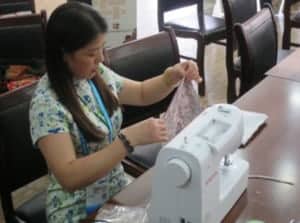
That was the initial constraint I was given, for my class. Through compromise and a lot of begging and pleading, even at the last minute, I got them to lend me about 4 sewing machines, and a couple of irons. And tables. The organizers of the class didn’t even think I needed tables for the students to work on. We managed to scrounge up about 8 tables. I took all of this in stride, as one must when one tries to get anything done in China.
Keep in mind that your students don’t have anything with them but their hands, no scissors, rotary tools, pins, rulers, thread or even sewing needles – nothing but their hands and willing hearts. We prepared 24 kits and precut everything and had the batting fused in place ready to go. But now imagine, you think you have accomplished all this, you’ve got your design ready, and on the day you are to teach those 20 people, over 50 people show up. And the organizers say, “That’s okay, the rest can watch.” Well, that just added to the chaos.
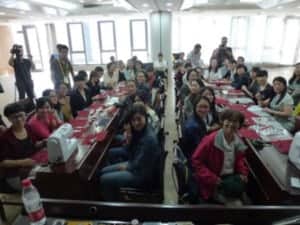
But I soldiered on, and indeed, by the 2 hour mark, a few had managed to finish the project. One lady made hers in 1 hour and 55 minutes, but she was an experienced bag maker in her own right. Some of the younger students left right at the 2 hour mark, but I did see some of them the very next day, and they used the sewing machines, which they shared, at the Singer booth across from us to finish the bags.
My husband watched the crowd and he was particularly impressed by one girl who worked diligently and completed the entire project by hand in about 2 and a quarter hours; she also helped several of her companions at different stages of the project.

For myself, I discovered that one of the young girls in the class was deaf, so I took her under my wing and made sure that she got every opportunity to do it herself. She was another who finished, in about 2 hours and 20 minutes, and she gave me a big hug at the end.
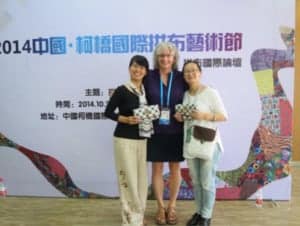
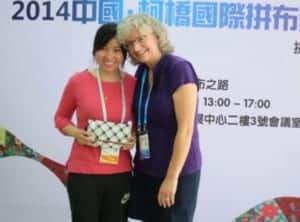
The students, male and female, were all extremely sharp, you only had to show them once, and they got it. Where will all this go? Will my designs ever be translated into Chinese? I don’t know. I know that there is a huge untapped market, and I know that I am pretty naïve about the dangers involved.
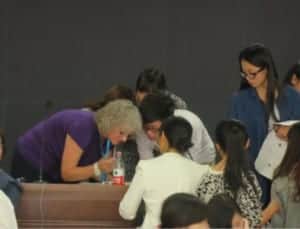
What will happen going forward?
Everyone wanted to know the cost of my bags. The Chinese people are used to seeing goods mass produced cheaply, and my bags look like luxury items to them – but they aren’t. Even the wives of the many local government officials who visited my booth don’t seem to understand what we are doing here and what we were asked to do.
We weren’t asked to sell bags. We weren’t even asked to promote the patterns. We were asked to come and promote quilting in China — the idea that anyone, with Brenda’s patterns, and access to sewing machines and fabric, can make beautiful quilts and bags themselves, and make them unique – the way they like: their own Chinese aesthetic. And in time, they could learn to design their own bags, their own quilts.
And as for the people here at the trade show who say they would like to mass produce my bags, or who would like to buy them already mass produced? I am not opposed to having one or two bag designs made on a mass market level – I’m certainly not opposed to making money — but the very last thing I want is to have someone take a design and set up a child-slave labor factory where they churn out “unique” bags and sell them all over the world. That is the antithesis of what I want to do.
I love sewing, and the only way to promote quilting is if others love it too. In any case, I wouldn’t know the first thing about how to proceed with getting my bags made cheaply and ethically. So essentially nothing has really happened yet. I collected business cards, I gave out cards. But I’m not sure what is going to happen next although I do expect things to happen.
Perhaps this trip was just an exploratory visit to China, where I laid the foundation of Guanxi, or “Good Relationships.”

Mary Ritter Beard said, “Certainly, travel is more than the seeing of sights, it is a change that goes on, deep and permanent, in the ideas of living.” What that change will mean to me in the future, I cannot guess, but I am certain that it will be deep and permanent.
Leave a Reply